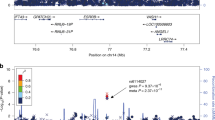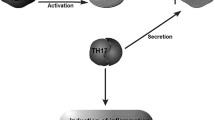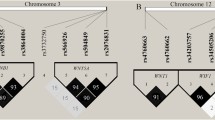Abstract
SP110 is a promising anti-Mycobacterium tuberculosis (MTB) gene. To investigate the effects of SP110 and its associated genes, i.e., MYBBP1A and RELA, on pathological progression of MTB infection, an association study with 424 patients of fresh pulmonary tuberculosis (PTB) and 424 healthy controls was performed. Moreover, classification and regression tree and multifactor dimensionality reduction were employed to explore the effects of gene–gene interactions on cavitary PTB. The results indicated that both the heterozygous genotype GC and homozygous genotype CC in rs3809849 had significant effects on the risk of PTB (OR 1.42, 95 % CI 1.06–1.92, p 0.019; OR 1.55, 95 % CI 1.04–2.33, p = 0.033, respectively), and heterozygous genotype CT in rs9061 also had similar effects (OR 1.43, 95 % CI 1.07–1.90, p = 0.014). The rs3809849 and rs9905742 in MYBBP1A were also significantly associated with cavitary PTB (p = 0.00046 and 0.039, respectively), while rs9061 in SP110 had no such association (p = 0.06931) except its significant association with non-cavitary PTB (p = 0.0093). The interaction of MYBBP1A and RELA had significant effect on cavitary PTB (OR 4.24, 95 % CI 1.44–12.49, p = 0.005). These suggest that MYBBP1A instead of SP110 may be a genetic risk factor for cavitary PTB and play important effects on its whole progress.

Similar content being viewed by others
Abbreviations
- MTB:
-
Mycobacterium tuberculosis
- MYBBP1A:
-
MYB-binding protein
- MDR:
-
Multifactor dimensionality reduction
- CART:
-
Classification and regression tree
- LR:
-
Logistic regression
References
WHO. Global tuberculosis control: WHO report 2011. Avenue: World Health Organization. 2011.
Sakamoto K. The pathology of Mycobacterium tuberculosis infection. Vet Pathol. 2012;49:423–39.
Pan H, Yan BS, Rojas M, et al. Ipr1 gene mediates innate immunity to tuberculosis. Nature. 2005;434:767–72.
Tosh K, Campbell SJ, Fielding K, et al. Variants in the SP110 gene are associated with genetic susceptibility to tuberculosis in West Africa. Proc Natl Acad Sci USA. 2006;103:10364–8.
Cai L, Deng SL, Liang L, et al. Identification of genetic associations of SP110/MYBBP1A/RELA with pulmonary tuberculosis in the Chinese Han population. Hum Genet. 2013;132:265–73.
Cai L, Pan H, Trzcinski K, Thompson CM, Wu Q, Kramnik I. MYBBP1A: a new Ipr1’s binding protein in mice. Mol Biol Rep. 2010;37:3863–8.
Owen HR, Elser M, Cheung E, Gersbach M, Kraus WL, Hottiger MO. MYBBP1a is a novel repressor of NF-kappa B. J Mol Biol. 2007;366:725–36.
Hahn LW, Ritchie MD, Moore JH. Multifactor dimensionality reduction software for detecting gene–gene and gene–environment interactions. Bioinformatics. 2003;19:376–82 (Oxford, England).
Jakulin ABI. Analyzing attribute dependencies. In: Lecture Notes in Computer Science, vol 2838; 2003. p. 229–40.
Dannenberg AM Jr. Delayed-type hypersensitivity and cell-mediated immunity in the pathogenesis of tuberculosis. Immunol Today. 1991;12:228–33.
Bloch DB, Nakajima A, Gulick T, et al. Sp110 localizes to the PML-Sp100 nuclear body and may function as a nuclear hormone receptor transcriptional coactivator. Mol Cell Biol. 2000;20:6138–46.
Dellaire G, Bazett-Jones DP. PML nuclear bodies: dynamic sensors of DNA damage and cellular stress. BioEssays. 2004;26:963–77.
Bocchino M, Galati D, Sanduzzi A, Colizzi V, Brunetti E, Mancino G. Role of mycobacteria-induced monocyte/macrophage apoptosis in the pathogenesis of human tuberculosis. Int J Tuberc Lung Dis. 2005;9:375–83.
Bonizzi G, Karin M. The two NF-kappaB activation pathways and their role in innate and adaptive immunity. Trends Immunol. 2004;25:280–8.
Chan ED, Morris KR, Belisle JT, et al. Induction of inducible nitric oxide synthase-NO* by lipoarabinomannan of Mycobacterium tuberculosis is mediated by MEK1-ERK, MKK7-JNK, and NF-kappaB signaling pathways. Infect Immun. 2001;69:2001–10.
Pahl HL. Activators and target genes of Rel/NF-kappaB transcription factors. Oncogene. 1999;18:6853–66.
Acknowledgments
The authors thank all study participants for their donation of blood samples. This work was supported by the National Infectious Disease Prevention and Cure Special Project (No. 2013ZX10003006-003-002), the National Nature Science Foundation of China (No. 31101015), the Foundation for Innovative Research Groups of the National Natural Science Foundation of China (No. 81421061) and the Scientific Research Foundation for the Returned Overseas Chinese Scholars, State Education Ministry (no.12Z102050009).
Conflict of interest
None.
Author information
Authors and Affiliations
Corresponding authors
Additional information
Shi-Yao Jiang and Lin-Lin Li have contributed equally to this work.
Electronic supplementary material
Below is the link to the electronic supplementary material.
Rights and permissions
About this article
Cite this article
Jiang, SY., Li, LL., Yue, J. et al. The effects of SP110’s associated genes on fresh cavitary pulmonary tuberculosis in Han Chinese population. Clin Exp Med 16, 219–225 (2016). https://doi.org/10.1007/s10238-015-0339-4
Received:
Accepted:
Published:
Issue Date:
DOI: https://doi.org/10.1007/s10238-015-0339-4




